- Introduction
- Stage 5 Post abandonment (phase h7e-h9m-J6A)
- Stage 4a Great Brickfall (phase h7e-h7d-J6A)
- Stage 4 Reorganization of space (phase h7d-h7a-J6A)
- Stage 3a Pit(phase h5c-h5d-J6A)
- Stage 3 Glacis(phase h4n-h3t-J6A)
- Stage 2 Construction and use of Staircase and Revetment Wall (phase h3s-h3m-J6A)
- Stage 1 Traces of earlier use (phases h3l-J6A)
Back to top: Depositional history for Unit J6
Introduction
J6 is the eastern limit of the temple terrace, marked by the revetment wall and the east staircase wall. The elevation in J6 is higher than elswhere in JP area. Here we are not in the plaza, where the elevation during the EDIII Period is about 85.00. The morphology of J6 is characterized by a slope, which during the Late Akkadian Period is at its highest point directly south of the revetment wall is about 91.00 and at its lower point, at the plaza level at 89.00. In the earliest phases, probaly early EDIII, I presume that here is the original surface of the terrace. Early Mittani levels are found on top of Late Third Millennium strata. The Early Second Millennium is here not attested, even if south of J6 there are structures dated to this period (Khabur).
Back to top: Depositional history for Unit J6
Stage 5 Post abandonment (phase h7e-h9m-J6A)
From the middle of the Mittani period onwards this part of the Temple Terrace was abandoned: a thick layer of natural accumulations with floating stones without human presence cover all this portion of the tell.
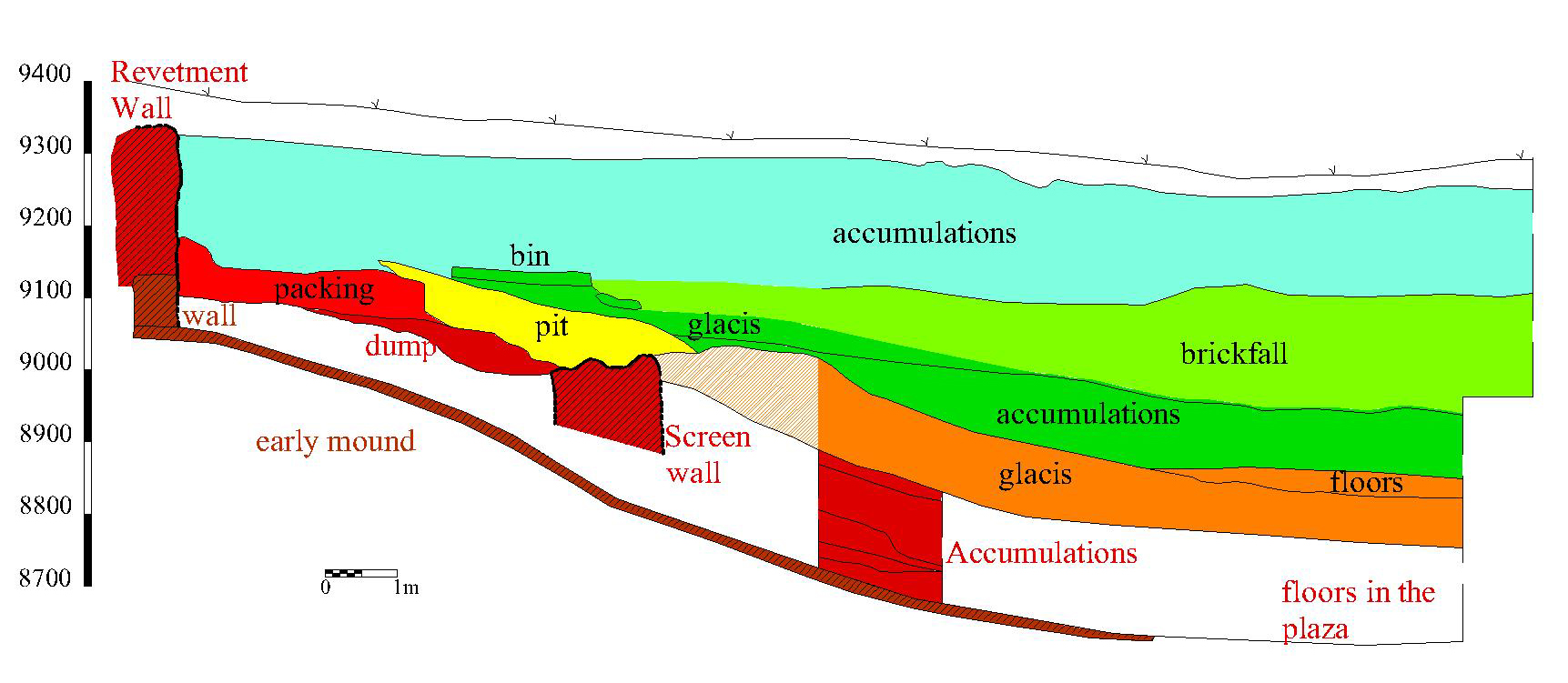 stage 5
stage 5
Back to top: Depositional history for Unit J6
Stage 4a Great Brickfall (phase h7e-h7d-J6A)
During the Middle of the Mittani period (light green)there is a collapse of a mudbrick building. The brickfall covered the glacis ^glacis1 and the bin a7. It continues to the west covering the plaza directly in front of the monumental staircase. The origin of the collapse is to be seen east of J6. The reason for the collapse is not clear, but just before the brick fall there is a thick layer in patches of ashy soil spread everywhere under the brick fall: it is possible that the area burned and afterwards the structure collapsed. The brick fall caused partly the blocking of the eastern side of the plaza, which, until the collapse, was an open space in front of the Temple Terrace, kept clean and free during the Third Millennium until the early Mittani.
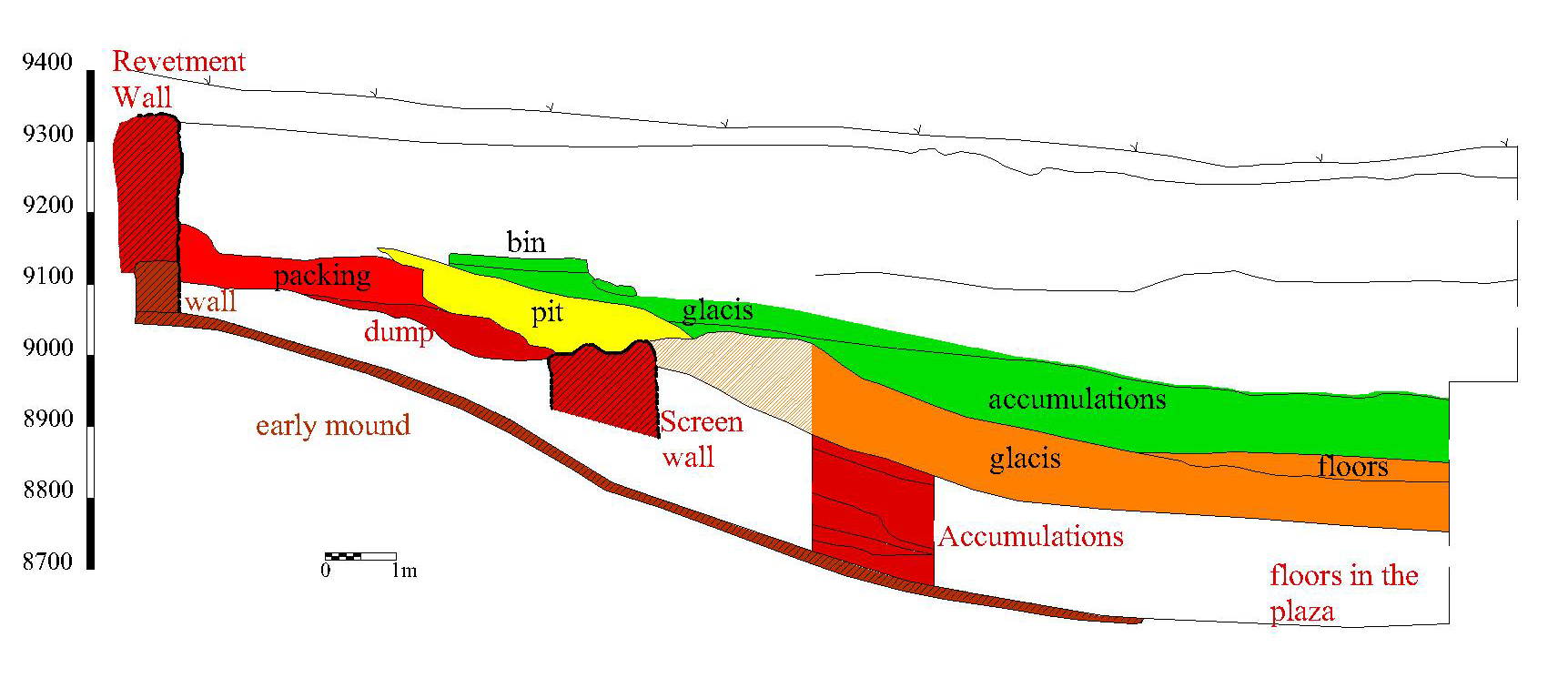 stage 4
stage 4
Back to top: Depositional history for Unit J6
Stage 4 Reorganization of space (phase h7d-h7a-J6A)
The very beginning of Mittani (indicated here in green) is still not clear in J6, since it was not extensively excavated: in this period we have a thick layer of a very wet and organic accumulation, plenty of pottery, charcoal and beads (f151) interrupted by patches of ashes; this layer sits directly on top of Third millennium layers. The rapid growth of sedimentation in this portion of the tell gives indication of a large presence of structures the south and east of the plaza. A surface sloping to the south east (^glacis1) covers the area and a shallow wall f202 is located on top of the glacis, at the same position of wall f227, which slightly later is used as base for the mudbrick bin a7, the last evidence of activities in J6. It was found empty and several use floors are associated to it.
 stage 4
stage 4
Back to top: Depositional history for Unit J6
Stage 3a Pit(phase h5c-h5d-J6A)
During this stage in yellow (Late Third Millennium BC) a shallow pit filled with ashes, carbon and large sherds cuts ^glacis3 and ^glacis8. Its function is not clear, but is probably related to activities in the neighborhood.
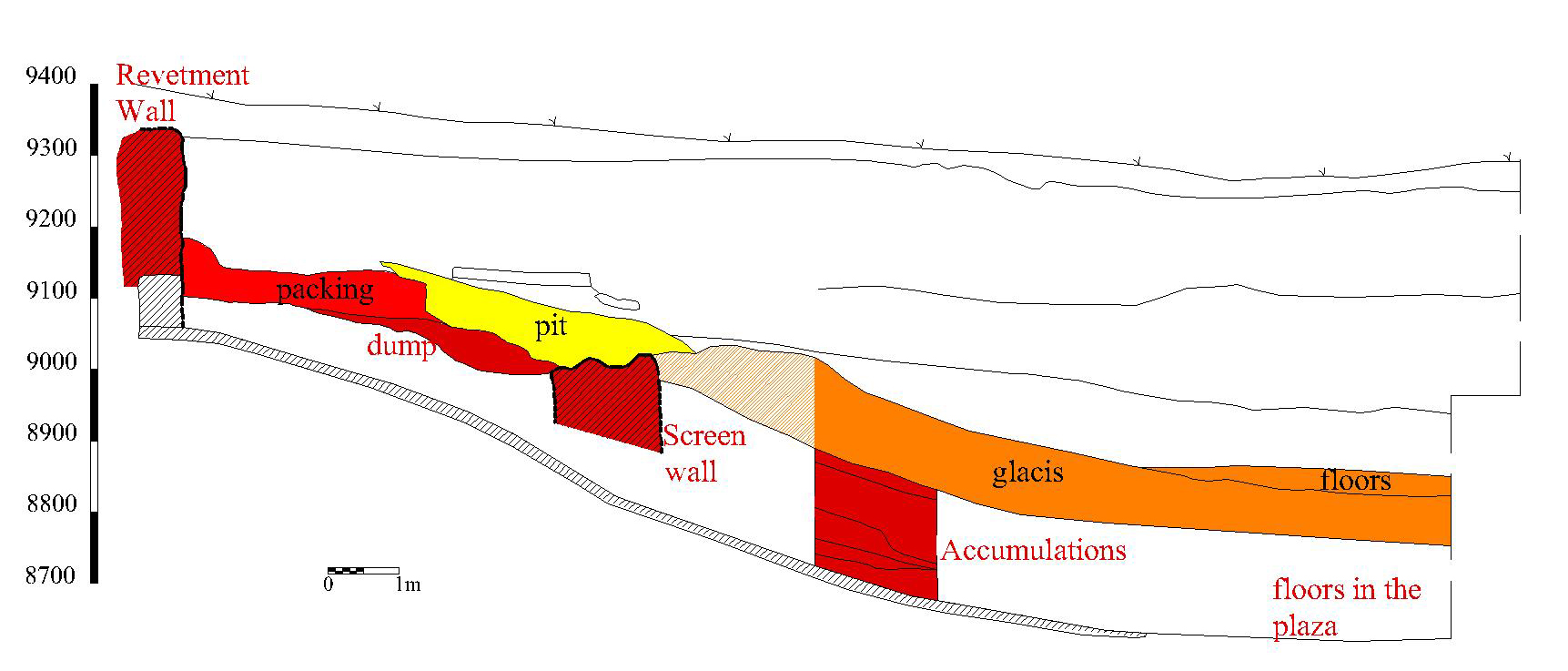 stage 3a
stage 3a
Back to top: Depositional history for Unit J6
Stage 3 Glacis(phase h4n-h3t-J6A)
An earth and bricky thick band (here in orange) (glacis and glacis) is dumped directly east of the staircase flanking wall and south of the Revetment Wall (in bright red). Screen Wall f227 is compleatly covered. A floor consisting in a compact surface with small pebbles and some sherds it can be associated to this phase: this floor is located very close to the staircase and in front of its eastern edge, continuing in front of the staircase and apron in J2 (J2f359).
 stage 3
stage 3
Back to top: Depositional history for Unit J6
Stage 2 Construction and use of Staircase and Revetment Wall (phase h3s-h3m-J6A)
Phase h3m-J6A (red color) is the major building phase for the Temple Terrace, where great monumentality is achieved. The revetment wall ^wall12 encloses the eastern side of the Temple Terrace; the staircase is built together with the revetment wall and wall6, built directly on top of the mound surface of stage 1. First accumulations are coming south of screen wall f227 and of wall6. In this period the area south of the staircase, the plaza, is intensively used: several floor surfaces were found both in J2 and J6 (v138).
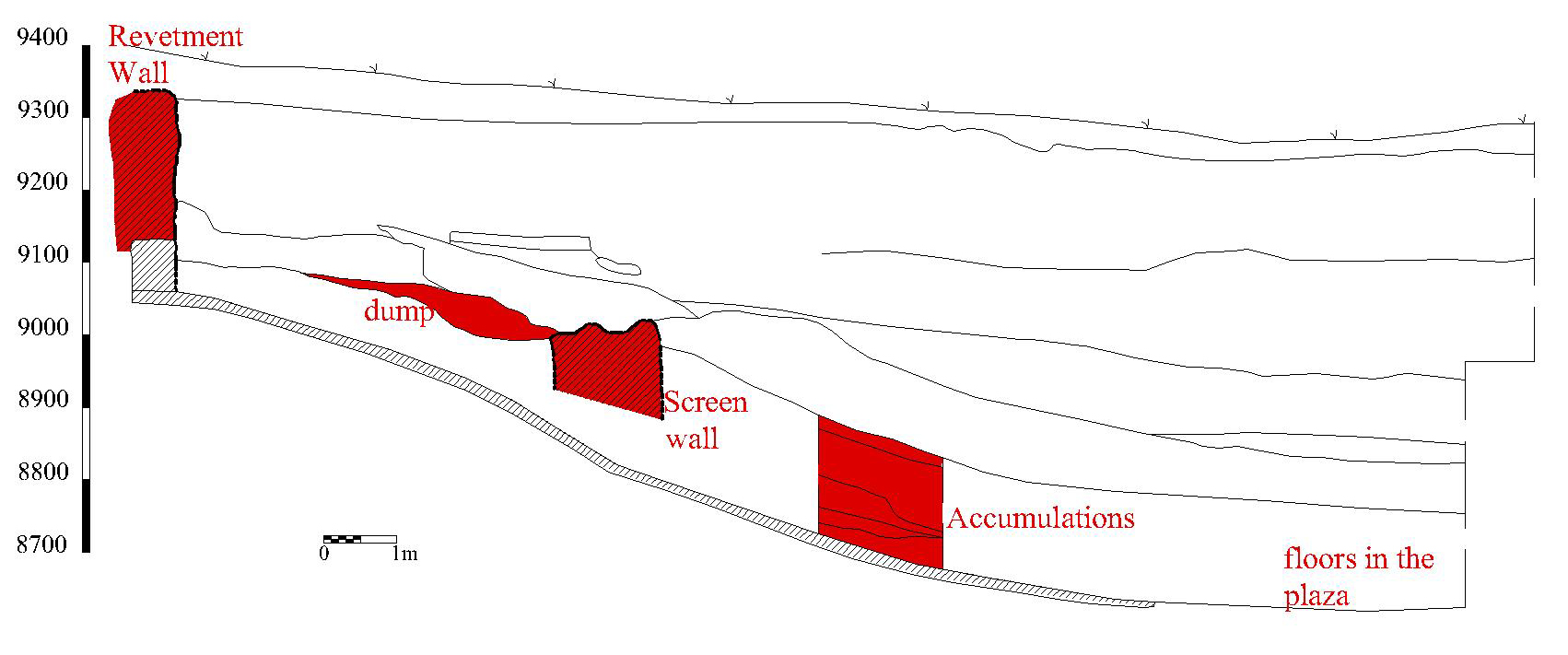 stage 2
stage 2
Back to top: Depositional history for Unit J6
Stage 1 Traces of earlier use (phases h3l-J6A)
The Late Chalcholithic phase in J6 is still not excavated but we can suppose from indication in other areas of JP that the Temple Terrace has a LC phase (see J1 and J3). In J2 there are three steps underlying the Third Millennium staircase and it is tempting to ascribe those steps to an earlier structure similar in function. In J6 there are a series of surfaces sloping south east, here indicated in maroon ^glacis9 and ^glacis10, which are located under the staircase flank ^wall6. A mudbrick wall ^wall13 could be a structure of this early period.
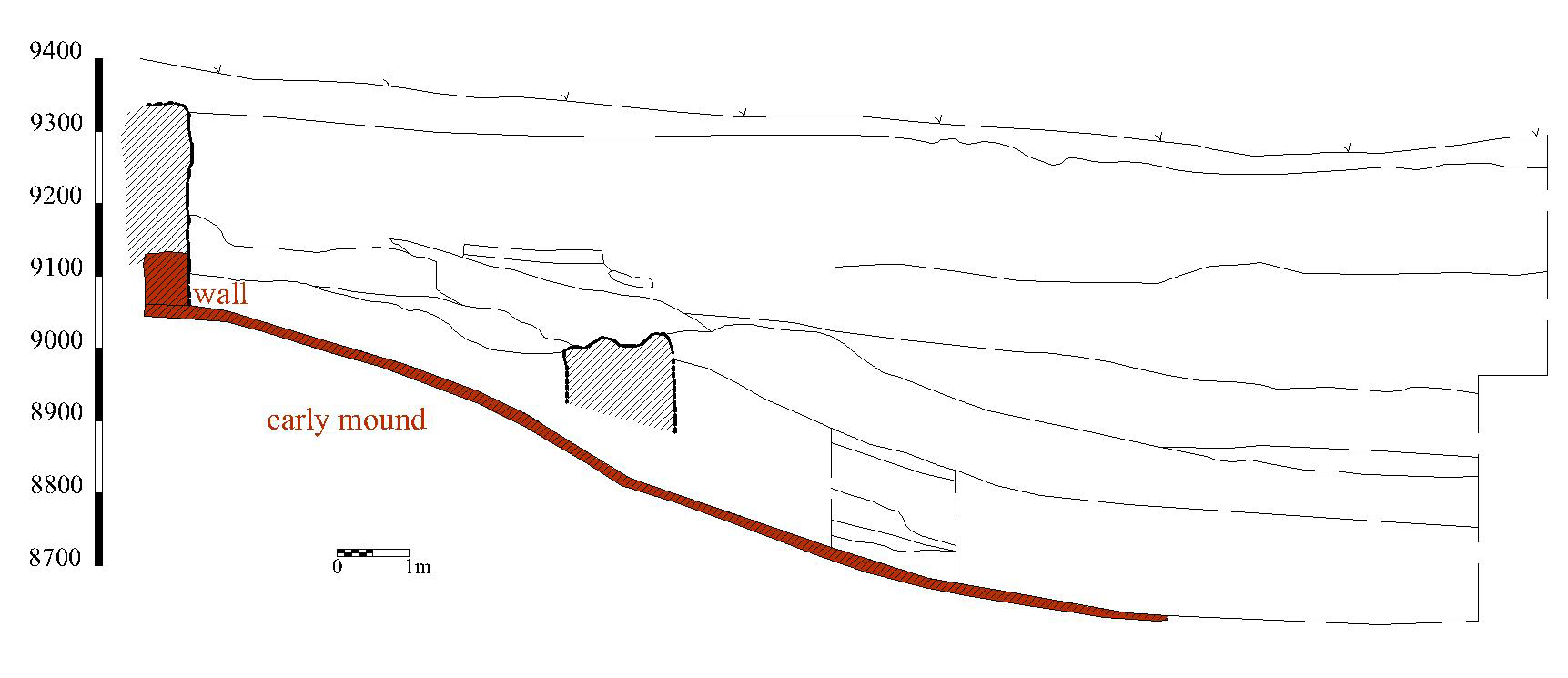 stage 1
stage 1
Back to top: Depositional history for Unit J6